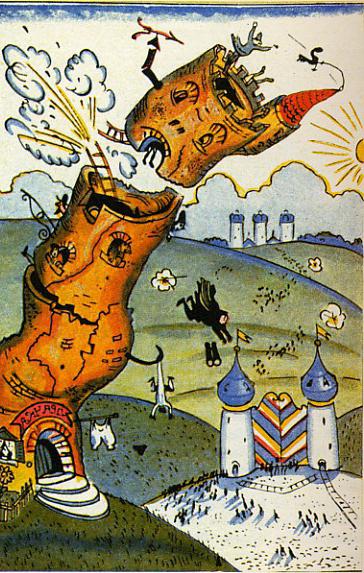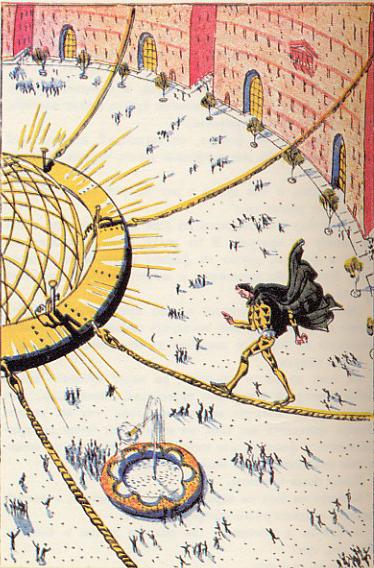"In a fairy tale - a lie, but in it ..." All Russian-speaking readers are familiar with the continuation of this well-known and somewhat erased quote. This comprehensive definition of a fairy tale by Pushkin is still relevant today, because for many this genre remains the standard of infinite wisdom, enclosed in simple forms and images. Such works are remembered for the rest of their adult life. One of them - the book "Three Fat Men" - is considered in this article.
Biography Facts
Despite the fact that the literary heritage of Yu. Olesha, consisting of the above-mentioned fairy tale, the novel “Envy”, stories and plays, is rather small, he deserves his place in Russian literature. The future writer was born in Yelisavetgrad (present-day Kirovograd), but spent his childhood and youth in Odessa. He was surrounded by eminent writers like Bagritsky and Kataev. Together with them, he moves to Moscow, which has just moved away from revolutionary events. There he met with writers who arrived in the capital from Kiev (for example, Bulgakov), got a job in the Gudok newspaper and, taking the pseudonym Zubilo, set about composing feyletons. The latter enjoyed stunning success.
The story of a fairy tale
The book "Three Fat Men" was written throughout 1924. The author came up with a plan when he saw a girl in the window of a neighboring house, Valya Grunzeid, who was reading Andersen's tales. The writer promised her that he would create something similar, and then, without particularly thinking about the issues of the party line, he set to work.
The creative process took place in the Buzzer building, which also served as a shelter for homeless writers. Olesha with pleasure remembered the eternally rolling barrel, which prevented the writer. With one hand he had to hold the naughty element of the poor decoration of the printing house, and with the other he created a book on rolls. In the end, the tale "Three Fat Men" was written and sent for print.
Plot component
From the first pages, the reader plunges into a fictional country ruled by three Fat Men. In their state, divided into rich and poor, revolution is gradually ripening. One of her ideological inspirers - Prospero's gunsmith - goes to jail. But his comrade, the tightrope walker Tibul, whom Dr. Gaspard hides from the all-seeing guard, sympathizing with the poor, is still at large. The revolutionary learns about a hidden underground passage leading directly to the Tolstyakov’s palace ...

Meanwhile, the guardsmen are breaking the doll of the heir to the rulers, the boy Tutti. The spoiled toy is given to Gaspar, who must repair it overnight, otherwise he will face the death penalty. Knowing that the order cannot be executed, the doctor takes the doll back to the palace, but loses it on the way. Looking for a toy, he stumbles upon a van of artists, where he meets a girl Suok, who looks like two drops of water to be lost. The girl, at the initiative of Tibula, enters the palace and frees Prospero. For this, she faces the death penalty, but the revolutionaries are ultimately lucky: the guards are on their side, and the unjust power has been thrown off. That’s the end of the tale.
Characters, ideological level, intertextuality
The image of the main character of the tale - Suok - was associated with dramatic events for the writer. Critics who wrote reviews of the book on Three Fat Men could not help but notice that the name of the girl is consonant with the name of Olga Suok - Olesha's wife. This was indicated by the writer himself in initiation, somewhat cunning with himself and his readers, because until the end of his days he remained in love with his wife’s younger sister, Seraphim. The girl reciprocated, however, being especially inconstant by nature, she constantly left Olesha. The last of her men was the notorious Victor Shklovsky, and Yuri, plagued by love experiences, married Olga. The image of a doll girl has not only a personal, but also a literary basis. It’s enough to recall the cardboard characters from Blok’s Carnival or Olympia from the famous Sandman of Hoffmann.

If the Soviet critic, intending to write a review on Three Fat Men, would certainly emphasize the revolutionary nature of the work, then modern interpretations allow us to delve into the problem level of the tale. So, the motive of a person’s struggle with the machine is connected with the already mentioned image of the doll, as well as with the scientist Tub sharpened together with Prospero. It was he who created the mechanical girl and refused by order of Tolstyakov to forge a mechanical heart for Tutti. An obvious reference to the famous scene in Andersen's “Snow Queen” slides here.
Tutti throughout the story, as it were, moves from the "mechanical" to the "living" world. Despite the fact that the venture with the heart failed, the Fat Men limited the heir's social circle to wild animals and a mechanical doll. It is no coincidence that it was the latent desire to open the boy a real life, even if it was shown in an ugly form, that moved the guardsman when he stabbed the mechanical analogue of Suok with his saber. The boy burst into tears of loss, and this for the Fat Men posed a much greater danger than all the speeches of the revolutionary Prospero. The emotions that arose at Tutti testified to the presence of a living soul, which means that the plan of the magnates remained unfulfilled.
Initial rejection
After the end, the tale "Three Fat Men" was supposed to lie at Olesha's table for three years. As you know, everything fantastic was not very welcome in those days. The future builder of communism just can not read fairy tales like such as "Three Fat Men". Reviews of the book were negative - well, this was to be expected. So, one of the few reviews was called something like this: "How not to write books for children." Now it seems surprising how the authority of the expressionistic, far from the aesthetics of socialist realism, the novel "Envy" was able to contribute to the publication of the writer’s tale in 1928.
Review by L. Chukovskoy
In 1940, Three Fat Men was published for the second time. Reviews of the book were again generally negative. Among them stood out a review of Lydia Chukovskaya, who, noting the undoubted merits of the book (the presence of a fascinating plot), claimed that the tale was "cold." According to the critic, she is not able to cause empathy for the main characters, in contrast to the works of the same Mark Twain. The main accusation of Lydia was that his works of Yu. Olesha - "Three Fat Men", "Envy" and stories - were saturated with excessive attention ... to subjects. So, behind such an interest in inanimate objects, complete indifference to people should have lurked.
Despite the fact that the ideological tale was sustained, a few extravagant turns - like "roses spilled like compote" - significantly impeded the perception of the main theme, that is, the struggle of the people with the oppressors. However, it is hardly worthwhile, creating your own opinion about the writer, rely on such comments and reviews: “Three Fat Men” Olesha wrote on the eve of the expressionistic manner of “Envy”, which became the hallmark of Russian literature of the 20s. Moreover, Lydia Chukovskaya herself, against her will, demonstrated excellent mastery of such a style, speaking of the “vagaries of the plot" drowning in a syrup waterfall and mountains of granulated sugar.
Positive reviews
Osip Mandelstam appreciated the Three Fat Men. The poet began his reviews of the book (or rather, the review) with the assumption: if Olesha's fairy tale were translated, then any of the Russian readers would have come to their senses and admitted that he did not know about such a skilled author. Meanwhile, Mandelstam bitterly noted that the critic, with his fear of capturing the young author, decided to bypass the tale. And completely in vain, because this is a prose of European proportions, which will be read by both adults and children.
The work of Olesha and modernity
As you can see, the prophecies of Mandelstam came true. The tale of Tibul and Suok turned out to be timeless. She was filmed, created theatrical versions, books with the inscription "Yu. Olesha "Three Fat Men" »decorated the shelves of libraries and shops, which once again testifies to the interest of the reading public in this work.